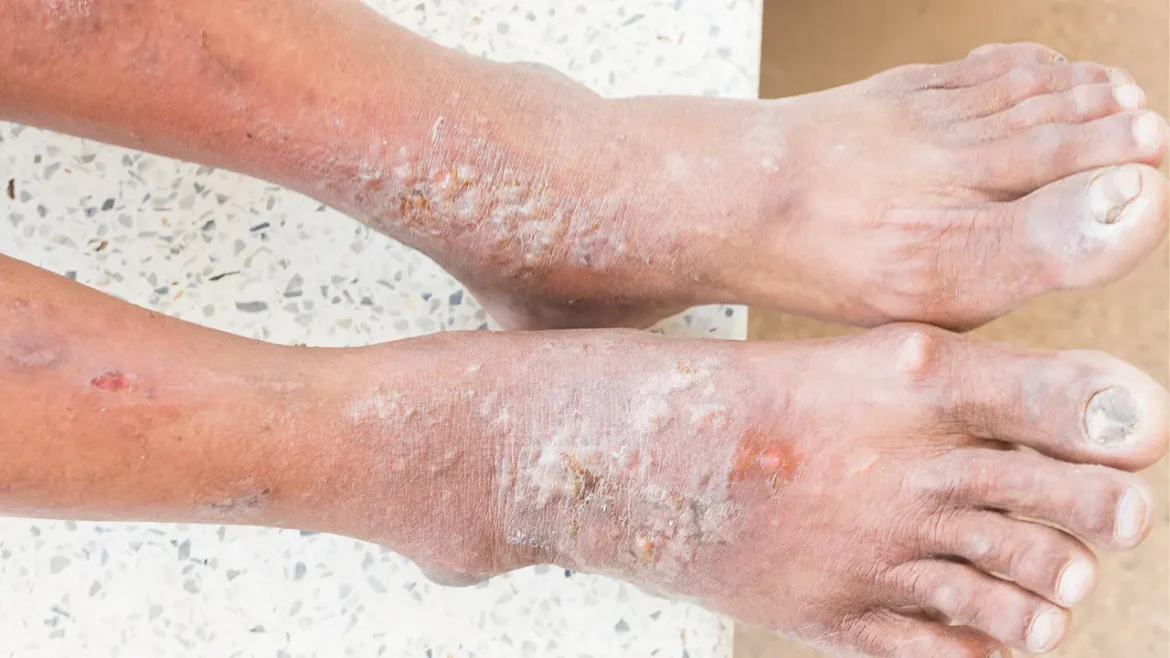Description
Cellulitis refers to an infection that affects the tissues under the skin. Usually, a little patch of inflammation and redness on the skin marks the beginning of the infection. The skin may feel heated to the touch and may become more swollen and redder as the inflammation and redness worsen over time. In some instances, the affected region might also acquire rashes or blisters.
Fever, chills, tiredness, and enlarged lymph nodes are some additional indications of cellulitis. When the infection is not treated, it can spread to the blood circulation and lymphatic system, which could result in more severe problems like sepsis.
You May Also Like:
HOO RAA CBD VS PARTNERED PROCESS CBD
SMILZ CBD GUMMIES VS PARTNERED PROCESS CBD GUMMIES
Cellulitis: Description, Causes, And Treatment Protocol is an original (HealthXWire) article.
Possible Causes
Cellulitis is a bacterial infection concerning the tissues underneath the skin and s can be brought on by a wide range of germs. Staphylococcus and streptococcus, which are often found on the skin’s outer layer but can penetrate your skin through a crack or break, constitute the most frequent bacteria responsible for contracting cellulitis.
Although cellulitis can develop anywhere in the body, it most frequently affects the lower part of the leg. This is so that bacteria can more easily enter the skin and lead to infection. The legs tend to be more susceptible to damage because they receive less blood flow than other areas on the body.
Insect bites, ulcers, burns, and surgical wounds, are additional cellulitis causes that can exist. Cellulitis can occasionally develop without a clear etiology or bacterial entry point.
Exacerbating and Mitigating Factors
The possibility of cellulitis can be increased or decreased by a number of variables. People can take precautions against cellulitis or lower their risk of recurring infections by staying aware of these variables.
The exacerbation factors leading to cellulitis include the following:
Obesity: Obesity can increase the risk of developing cellulitis because it causes skin creases and wet areas where germs can grow more easily.
Weak Immune System: Cellulitis is more probable to occur among individuals with compromised immune systems, notably those suffering from AIDS or HIV or if they are undergoing chemotherapy.
Diabetes: Due to their weaker immune systems along with poor circulation, individuals who have diabetes are more prone to infections, such as cellulitis.
Lymphedema: As a result of a blockage within the lymphatic system, lymphedema is a disorder that results in inflammation in the legs or arms. By forming folds in the skin that are particularly vulnerable to chafing and splitting, the swelling can raise the danger of bacterial infections including cellulitis.
Chronic Skin zconditions: Eczema and psoriasis are examples of chronic skin disorders that can compromise the skin barrier, thereby rendering it easy for germs to penetrate the skin and trigger infections.
Intravenous Drug Usage: Because intravenous administration of drugs directly introduces the bacteria inside the bloodstream, it raises the risk of bacteria-related infections like cellulitis.
The mitigating factors leading to cellulitis include the following:
Good Hygiene: Maintaining proper hygiene will help stop the transmission of bacteria that may lead to cellulitis. This includes frequent bathing and hand washing.
Treating Underlying Health Problems: The chance of acquiring cellulitis can be decreased by treating underlying health problems like diabetes or lymphedema.
Proper Wound Care: Cleansing and treating wounds and cuts away can assist in preventing infection and lowering the chance of getting cellulitis.
Protective Gear: Wearing safety equipment, like gloves and masks, can help reduce exposure to potentially dangerous conditions and lower the risk of contracting cellulitis.
Keeping a Healthy Weight: By removing skin folds and damp regions that can be more conducive to bacterial growth, keeping a healthy weight can help lower the chance of developing cellulitis.
Refrain from Sharing Personal Goods: Razors, nail clippers, and towels should not be shared in order to limit the transmission of bacteria that can cause cellulitis.

Standard Treatment Protocol(s)
An antibiotic regimen is often used as the primary treatment for cellulitis. The extent of the infection along with its root causes will determine the kind of antibiotic that is recommended. Oral medicines like penicillin and cephalosporins are known to be effective. Nevertheless, intravenous antibiotics may be required in more serious situations.
In conjunction with antibiotics, other therapies could be suggested to help alleviate the cellulitis problems. These might consist of the following:
- Elevating the injured limb to relieve swelling
- Using warm compresses for relieving pain and suffering in the afflicted region
- Applying over-the-counter analgesics like ibuprofen or acetaminophen
- Putting on bandages or compression stockings for improved blood flow


Treatment Options
For controlling and avoiding cellulitis, there are various different therapeutic options available as a complement to the standard approach. They consist of the following:
Prescription Medications:
- Antibiotics
Antibiotics are the usual course of treatment for cellulitis, as already indicated. Some individuals, however, might be allergic to specific antibiotics or might encounter negative side effects. A different antibiotic might be recommended in such circumstances.
- Nonsteroidal Anti-inflammatory Drugs (NSAIDs)
Cellulitis pain can be treated with prescription NSAIDs like celecoxib or ibuprofen. Such medications can also help decrease temperatures and inflammation.
- Pain Relievers
Prescription painkillers may be advised if cellulitis-related discomfort and pain are severe.
Over-the-Counter Formulations:
The over-the-counter medications discussed below are effective at treating cellulitis:
- Pain Relievers
Cellulitis-related discomfort can also be managed using over-the-counter analgesics like acetaminophen or ibuprofen. Such drugs can also help lower temperature and inflammation.
- Topical Antibiotics
Small cuts and wounds that could become infected and result in cellulitis can be treated with over-the-counter topically administered antibiotics like neomycin or bacitracin. The afflicted region should be covered using a sterile dressing after these creams have been administered.
Nutritional Supplements:
The following dietary supplements aid in the treatment of cellulitis:
- Vitamin C
Antioxidant vitamin C aids in strengthening the body’s immune system and accelerating wound healing. Supplementing with vitamin C can lower the risk of developing cellulitis and hasten recovery time.
- Zinc
Another essential vitamin that contributes to immune health and the healing of wounds is zinc. Supplementing with zinc can lessen the chances of developing cellulitis and accelerate the healing process.
- Probiotics
Probiotics are helpful bacteria that support the gut’s delicate microbiome by helping to keep it in balance. Additionally, they can support a stronger immune system and decrease the possibility of infections like cellulitis.
Natural Remedies and Herbal Remedies:
The following are some herbal and natural treatments for cellulitis:
- Tea Tree Oil
Essential oil with natural antibacterial characteristics make up the important components of tea tree oil. Tea tree oil used directly in the afflicted region may aid in eradicating bacteria and avoiding infections.
- Echinacea
For many years, people have used the plant echinacea to strengthen their immune systems and combat illnesses. It can lessen the intensity of symptoms and assist in avoiding cellulitis.
- Turmeric
It has been demonstrated that turmeric works as an all-natural anti-inflammatory to reduce swelling and inflammation. Consuming turmeric pills or incorporating them into food can help lessen cellulitis-related inflammation.
- Garlic
Garlic has natural antibiotics and anti-inflammatory agents. Garlic supplements or just raw garlic consumption can support a strong immune system and decrease cellulitis-related inflammation.


Management and Prevention
There are many kinds of methods for managing and preventing cellulitis along with available treatments. These include the following:
Keeping the Skin Dry and Clean: Bacteria can infiltrate the skin through tiny cuts or scrapes if it isn’t regularly washed with water and soap and also dried completely.
Treating Skin Injuries as Soon as Possible: If neglected, even minor wounds or scrapes can result in cellulitis. All skin injuries must be cleaned and dressed right away to lower the possibility of infection.
Wearing Protective Clothing: Wearing protective clothing, for example, boots, and long sleeves, might help in avoiding injuries and minimize the possibility of cellulitis while working in places where there is a substantial possibility of skin injuries, like industrial settings or construction premises.
Managing Underlying Medical Issues: Cellulitis risk can be exacerbated by medical conditions like diabetes, poor circulation, and lymphedema. Reduced risk can be achieved by effective management of certain disorders.


Conclusion
It is crucial to remember that while such procedures for treating cellulitis could be beneficial as supplemental therapies, they ought not to ever be used in place of conventional medical care. A healthcare professional should always be consulted before beginning a new treatment plan.
Additional resources for further reference
https://www.aad.org/public/diseases/a-z/cellulitis-causes
https://www.medicalnewstoday.com/articles/152663
https://www.nhs.uk/conditions/cellulitis/
Important Note: The information contained in this article is for general informational purposes only, and should not be construed as health or medical advice, nor is it intended to diagnose, prevent, treat, or cure any disease or health condition. Before embarking on any diet, fitness regimen, or program of nutritional supplementation, it is advisable to consult your healthcare professional in order to determine its safety and probable efficacy in terms of your individual state of health.
Regarding Nutritional Supplements Or Other Non-Prescription Health Products: If any nutritional supplements or other non-prescription health products are mentioned in the foregoing article, any claims or statements made about them have not been evaluated by the U.S. Food and Drug Administration, and such nutritional supplements or other health products are not intended to diagnose, treat, cure, or prevent any disease.
Table of Contents


